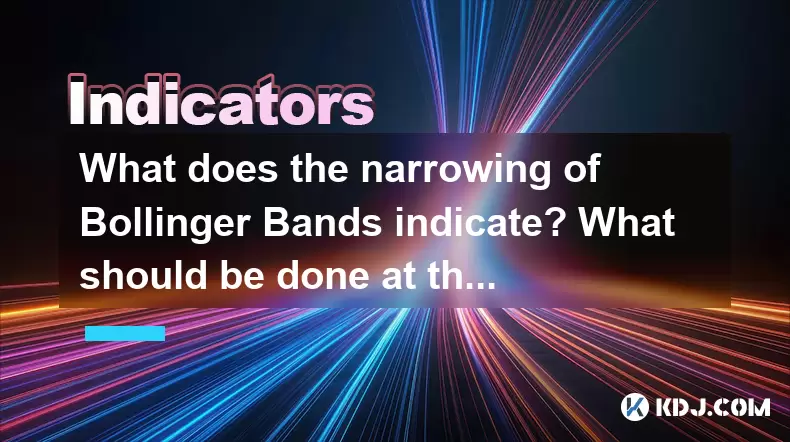-
 bitcoin
bitcoin $109547.008142 USD
0.04% -
 ethereum
ethereum $4011.838726 USD
-0.05% -
 tether
tether $1.000402 USD
-0.01% -
 xrp
xrp $2.798606 USD
0.88% -
 bnb
bnb $970.877944 USD
1.39% -
 solana
solana $202.237275 USD
-0.95% -
 usd-coin
usd-coin $0.999673 USD
0.00% -
 dogecoin
dogecoin $0.229294 USD
-1.15% -
 tron
tron $0.336370 USD
-0.45% -
 cardano
cardano $0.777260 USD
-1.66% -
 hyperliquid
hyperliquid $45.503019 USD
1.73% -
 ethena-usde
ethena-usde $1.000362 USD
0.01% -
 chainlink
chainlink $20.785303 USD
-1.10% -
 avalanche
avalanche $28.755822 USD
-0.11% -
 stellar
stellar $0.358303 USD
-0.48%
What does the narrowing of Bollinger Bands indicate? What should be done at this time?
Narrowing Bollinger Bands signal low volatility in crypto markets, often preceding significant price movements; traders should prepare for potential breakouts.
May 21, 2025 at 10:35 pm

The narrowing of Bollinger Bands is a significant technical indicator in the cryptocurrency market that traders and investors closely monitor. Bollinger Bands are a type of statistical chart characterizing the prices and volatility over time of a financial instrument or commodity, including cryptocurrencies. They consist of a middle band being a simple moving average (SMA) and two outer bands that are standard deviations away from the middle band. When these bands narrow, it suggests that the market is experiencing low volatility. This article will delve into what the narrowing of Bollinger Bands indicates and what actions should be taken during such periods.
Understanding Bollinger Bands
Before diving into the specifics of narrowing Bollinger Bands, it's essential to understand how these bands work. Bollinger Bands were developed by John Bollinger and are used to measure market volatility and identify potential buy and sell signals. The middle band is typically a 20-period simple moving average, while the upper and lower bands are set two standard deviations away from the middle band. When the bands are wide, it indicates high volatility, and when they are narrow, it suggests low volatility.
What Does Narrowing of Bollinger Bands Indicate?
The narrowing of Bollinger Bands is often referred to as the squeeze. This phenomenon occurs when the upper and lower bands move closer together, indicating that the market is experiencing a period of low volatility. This can be a critical signal for traders because it often precedes a significant price movement. The squeeze suggests that the market is consolidating, and a breakout could be imminent.
Why is the Narrowing of Bollinger Bands Significant?
The significance of the narrowing of Bollinger Bands lies in its predictive nature. When the bands narrow, it means that the market is in a state of equilibrium, with little fluctuation in price. This period of low volatility can be the calm before the storm, as it often leads to a breakout in either direction. Traders use this signal to prepare for potential market moves, as the breakout can result in significant price changes.
How to Identify the Narrowing of Bollinger Bands
Identifying the narrowing of Bollinger Bands involves observing the distance between the upper and lower bands. Here's how to do it:
- Open your trading platform and select the cryptocurrency chart you wish to analyze.
- Apply the Bollinger Bands indicator to the chart. Most platforms have this indicator built-in and can be added with a few clicks.
- Observe the bands over time. If you notice that the upper and lower bands are moving closer together, this indicates that the bands are narrowing.
- Compare the current width of the bands to historical data to confirm that the bands are indeed narrowing.
What Should Be Done When Bollinger Bands Narrow?
When Bollinger Bands narrow, traders need to take specific actions to prepare for potential market movements. Here's what should be done:
Prepare for a Breakout
The narrowing of Bollinger Bands often precedes a breakout, so traders should be ready for a significant price movement. This involves:
- Monitoring the market closely for signs of a breakout. Look for increased volume or other technical indicators that suggest a move is imminent.
- Setting up alerts on your trading platform to notify you when the price breaks out of the Bollinger Bands.
- Positioning yourself to take advantage of the breakout. This could mean setting up buy or sell orders near the upper or lower bands.
Adjust Trading Strategies
During periods of low volatility, traders may need to adjust their strategies. This can include:
- Scaling back on trading activity. Since the market is not moving much, it may not be the best time to make large trades.
- Focusing on smaller, more frequent trades. If you do decide to trade, consider making smaller trades to manage risk.
- Using other indicators in conjunction with Bollinger Bands to confirm signals. For instance, the Relative Strength Index (RSI) or Moving Average Convergence Divergence (MACD) can provide additional insights.
Use Bollinger Bands in Conjunction with Other Indicators
While Bollinger Bands are a powerful tool, they should not be used in isolation. Combining them with other indicators can provide a more comprehensive view of the market. Here's how to do it:
- Add the RSI indicator to your chart. The RSI can help confirm whether the market is overbought or oversold, which can be useful during a breakout.
- Include the MACD indicator to identify potential trend changes. The MACD can help confirm whether the breakout is likely to continue or reverse.
- Use volume indicators to gauge the strength of the breakout. High volume during a breakout can indicate a more significant move.
Practice Risk Management
Risk management is crucial during periods of low volatility and potential breakouts. Here are some steps to take:
- Set stop-loss orders to limit potential losses if the market moves against your position.
- Use position sizing to ensure that no single trade can significantly impact your overall portfolio.
- Diversify your holdings to spread risk across different cryptocurrencies and assets.
Stay Informed
Staying informed about market conditions and news can help you make better trading decisions. This includes:
- Following cryptocurrency news sources to stay updated on market developments.
- Joining trading communities to share insights and learn from other traders.
- Keeping an eye on economic indicators that could impact the cryptocurrency market, such as inflation rates or regulatory news.
Frequently Asked Questions
Q: Can the narrowing of Bollinger Bands be a false signal?A: Yes, the narrowing of Bollinger Bands can sometimes be a false signal. It's important to use other indicators and market analysis to confirm the potential breakout. False signals can occur if the market remains in a state of low volatility for an extended period without a significant move.
Q: How long does it typically take for a breakout to occur after Bollinger Bands narrow?A: The timing of a breakout after Bollinger Bands narrow can vary widely. It could happen within a few days or take several weeks. Traders should remain vigilant and use other indicators to gauge the likelihood and timing of a breakout.
Q: Should I trade during periods of low volatility indicated by narrow Bollinger Bands?A: Trading during periods of low volatility can be challenging due to the lack of significant price movement. Some traders choose to wait for a breakout, while others may engage in smaller, more frequent trades to manage risk. It's essential to adjust your trading strategy based on the market conditions.
Q: Can Bollinger Bands be used for all cryptocurrencies?A: Yes, Bollinger Bands can be applied to any cryptocurrency chart. However, the effectiveness of the indicator may vary depending on the liquidity and volatility of the specific cryptocurrency. It's crucial to test the indicator on different assets to understand its performance.
Disclaimer:info@kdj.com
The information provided is not trading advice. kdj.com does not assume any responsibility for any investments made based on the information provided in this article. Cryptocurrencies are highly volatile and it is highly recommended that you invest with caution after thorough research!
If you believe that the content used on this website infringes your copyright, please contact us immediately (info@kdj.com) and we will delete it promptly.
- Crypto Whales, PEPE, and Meme Coins: What's the Hype?
- 2025-09-28 18:25:15
- Cathie Wood, Hyperliquid, and Solana Development: A New Era in Crypto?
- 2025-09-28 19:05:16
- Polkadot pUSD: NYC's Take on Decentralized Stability
- 2025-09-28 18:25:15
- Chainlink, Remittix, and Price Gains: A Tale of Two Cryptos
- 2025-09-28 19:05:16
- Altcoins, Portfolios, and Millions: Decoding the Crypto Bull Run
- 2025-09-28 19:10:01
- SWIFT, Ethereum, and Linea: Revolutionizing Global Banking?
- 2025-09-28 18:30:01
Related knowledge

What is a tower bottom candlestick pattern? Does it have a high success rate?
Sep 22,2025 at 07:18am
Tower Bottom Candlestick Pattern Explained1. The tower bottom candlestick pattern is a reversal formation that typically appears at the end of a downt...

What is a black hole pattern in the MACD indicator? Is it a cause for concern?
Sep 21,2025 at 06:54pm
Bitcoin's Role in Decentralized Finance1. Bitcoin remains the cornerstone of decentralized finance, serving as a benchmark for value and security acro...

How can I use the psychological line (PSY) to determine market sentiment?
Sep 17,2025 at 02:19pm
Understanding the Psychological Line (PSY) in Cryptocurrency TradingThe Psychological Line, commonly referred to as PSY, is a momentum oscillator used...

How can I determine if a double top pattern has officially formed?
Sep 21,2025 at 03:18am
Understanding the Structure of a Double Top Pattern1. A double top pattern consists of two distinct peaks that reach approximately the same price leve...

What is the Golden Valley pattern on the moving average? Is it better than the Silver Valley pattern?
Sep 21,2025 at 02:54pm
Understanding the Golden Valley Pattern in Moving Averages1. The Golden Valley pattern is a technical formation observed in cryptocurrency price chart...

What does a death cross of the RSI in the strong zone (above 50) mean?
Sep 17,2025 at 10:54pm
Understanding the Death Cross in RSI Context1. The term 'death cross' is traditionally associated with moving averages, where a short-term average cro...

What is a tower bottom candlestick pattern? Does it have a high success rate?
Sep 22,2025 at 07:18am
Tower Bottom Candlestick Pattern Explained1. The tower bottom candlestick pattern is a reversal formation that typically appears at the end of a downt...

What is a black hole pattern in the MACD indicator? Is it a cause for concern?
Sep 21,2025 at 06:54pm
Bitcoin's Role in Decentralized Finance1. Bitcoin remains the cornerstone of decentralized finance, serving as a benchmark for value and security acro...

How can I use the psychological line (PSY) to determine market sentiment?
Sep 17,2025 at 02:19pm
Understanding the Psychological Line (PSY) in Cryptocurrency TradingThe Psychological Line, commonly referred to as PSY, is a momentum oscillator used...

How can I determine if a double top pattern has officially formed?
Sep 21,2025 at 03:18am
Understanding the Structure of a Double Top Pattern1. A double top pattern consists of two distinct peaks that reach approximately the same price leve...

What is the Golden Valley pattern on the moving average? Is it better than the Silver Valley pattern?
Sep 21,2025 at 02:54pm
Understanding the Golden Valley Pattern in Moving Averages1. The Golden Valley pattern is a technical formation observed in cryptocurrency price chart...

What does a death cross of the RSI in the strong zone (above 50) mean?
Sep 17,2025 at 10:54pm
Understanding the Death Cross in RSI Context1. The term 'death cross' is traditionally associated with moving averages, where a short-term average cro...
See all articles









































































